This month our body language expert, Peter Clayton looks at the complex subject of profiling and how it can help you better understand your delegates.
Following my last article, Dr. Suzanne Hard commented that some of the scientists that she works with have trouble with understanding why they should smile and make eye contact when talking to others.
Whilst my main focus is on body language, there is something else that should be factored in when observing body language and that is behaviour profiling or personality profiling. Many of us want the same things but for different reasons. Most of us take in knowledge and analyse it in different ways.
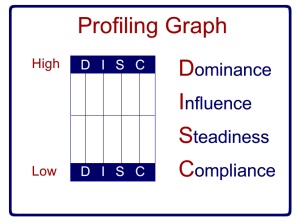 The DISC system
The DISC system
I use the DISC profiling system (Dominance, Influence, Steadiness, and Compliance) for training course analysis because it is quick and easy to use. I can read different personalities and the body language I would expect from them. This tells me how keen they are to be on the course or if they have been told to attend. It also helps me spot those who are worried that they will get chosen for role-play.
This takes places whilst they introduce themselves and the response allows me to tailor the first stages of the course so it will come together quicker. I can’t go into a great deal of detail here but if there is more interest I would be happy to write more about the subject. As previously mentioned, I use the DISC system and the first personality type one on the list is the “D”
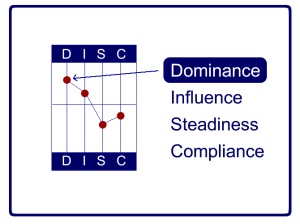 Dominance “The High D”
Dominance “The High D”
Dominant people have very strong solid body language. They are positive and confident about what they believe. They will not flinch from conflict easily. Eye contact is normally in excess of 95% of the time. They use much shorter sentences when asking or answering questions.
So, stick to the point when explaining things and be prepared for them to argue on important points
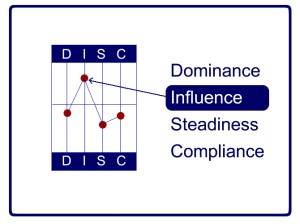 Influencer “The High I”
Influencer “The High I”
Influential people maintain eye contact for about 75% of the time. They also look up quite a bit when recalling incidents as they store memories in picture format. They would remember who was on the course and the people they got on well with. They sometimes stray away from the point and personalise their comments to include feelings. (The Dominant person on the other hand would remember facts and figures about the course.) The Influencer’s body language is more animated and they tend to be more enthusiastic and vocal if they are enjoying themselves.
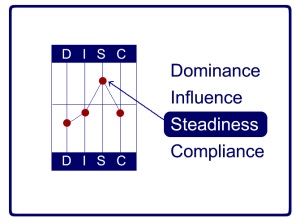 Steadiness “The High S”
Steadiness “The High S”
The Steady person is probably what I think Dr. Suzanne Hard is describing, because the steady person’s body language is quiet and reserved, eye contact is much lower and they break eye contact pretty quickly when you look at them for more than a few seconds. They make fewer body language movements and appear to be relaxed and sometimes disconnected, but they are usually soaking up information and analysing it in their own way.
I often think of the Steady person as clever, thinking things through. However, on a training course they may appear to be unresponsive because of this.
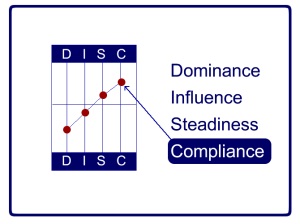 Compliance “The High C”
Compliance “The High C”
Finally, the Compliant person’s body language is very similar to that of the Dominant person. Strong eye contact, they know what they want and they expect you to stick to the agenda and the rules. The main difference between the Dominant and Compliant person is that the Dominant uses the “I” word: “What I want to get out of the course …” ,“What I want to learn …” The Compliant person uses “we": “What we expect as a company to get from this …”, “How we normally do things is …”
Profiling can complicate things for anyone learning body language because of the differences and discrepancies between different profiles, but it is worth becoming familiar with both.
I would normally expect to have three of the four different profiles on every training course. With the Dominant person I explain things more precisely and expect them to agree or disagree and the will say so.
The Influencer likes talking to people who like them, so I have to explain things in a more enthusiastic and interesting way and the Steady and Compliant people need more scientific explanations with proof and statements to justify what I am saying.
I think this makes profiling and body language that much more rewarding for a trainer who may be delivering a course on a regular basis because of the different personalities involved.
Peter Clayton will be running his ‘Body workshop at TrainingZone Live looking exploring how body language effects business and life interactions. Find out more here.
Read more of Peter’s articles:
Peter Clayton is a leading body language expert, speaker and trainer as well as a consultant for the BBC and ITV. He writes for a wide range of national papers and magazines and is a specialist consultant to other speakers, leading businesses, celebrities and politicians. For more information, visit his website: www.peterclayton.com.
This month our body language expert, Peter Clayton looks at the complex subject of profiling and how it can help you better understand your delegates.
Following my last article, Dr. Suzanne Hard commented that some of the scientists that she works with have trouble with understanding why they should smile and make eye contact when talking to others.
Whilst my main focus is on body language, there is something else that should be factored in when observing body language and that is behaviour profiling or personality profiling. Many of us want the same things but for different reasons. Most of us take in knowledge and analyse it in different ways.
 The DISC system
The DISC system
I use the DISC profiling system (Dominance, Influence, Steadiness, and Compliance) for training course analysis because it is quick and easy to use. I can read different personalities and the body language I would expect from them. This tells me how keen they are to be on the course or if they have been told to attend. It also helps me spot those who are worried that they will get chosen for role-play.
This takes places whilst they introduce themselves and the response allows me to tailor the first stages of the course so it will come together quicker. I can’t go into a great deal of detail here but if there is more interest I would be happy to write more about the subject. As previously mentioned, I use the DISC system and the first personality type one on the list is the “D”
 Dominance “The High D”
Dominance “The High D”
Dominant people have very strong solid body language. They are positive and confident about what they believe. They will not flinch from conflict easily. Eye contact is normally in excess of 95% of the time. They use much shorter sentences when asking or answering questions.
So, stick to the point when explaining things and be prepared for them to argue on important points
 Influencer “The High I”
Influencer “The High I”
Influential people maintain eye contact for about 75% of the time. They also look up quite a bit when recalling incidents as they store memories in picture format. They would remember who was on the course and the people they got on well with. They sometimes stray away from the point and personalise their comments to include feelings. (The Dominant person on the other hand would remember facts and figures about the course.) The Influencer’s body language is more animated and they tend to be more enthusiastic and vocal if they are enjoying themselves.
 Steadiness “The High S”
Steadiness “The High S”
The Steady person is probably what I think Dr. Suzanne Hard is describing, because the steady person’s body language is quiet and reserved, eye contact is much lower and they break eye contact pretty quickly when you look at them for more than a few seconds. They make fewer body language movements and appear to be relaxed and sometimes disconnected, but they are usually soaking up information and analysing it in their own way.
I often think of the Steady person as clever, thinking things through. However, on a training course they may appear to be unresponsive because of this.
 Compliance “The High C”
Compliance “The High C”
Finally, the Compliant person's body language is very similar to that of the Dominant person. Strong eye contact, they know what they want and they expect you to stick to the agenda and the rules. The main difference between the Dominant and Compliant person is that the Dominant uses the “I” word: “What I want to get out of the course …” ,“What I want to learn …” The Compliant person uses “we": “What we expect as a company to get from this …”, “How we normally do things is …”
Profiling can complicate things for anyone learning body language because of the differences and discrepancies between different profiles, but it is worth becoming familiar with both.
I would normally expect to have three of the four different profiles on every training course. With the Dominant person I explain things more precisely and expect them to agree or disagree and the will say so.
The Influencer likes talking to people who like them, so I have to explain things in a more enthusiastic and interesting way and the Steady and Compliant people need more scientific explanations with proof and statements to justify what I am saying.
I think this makes profiling and body language that much more rewarding for a trainer who may be delivering a course on a regular basis because of the different personalities involved.
Peter Clayton will be running his 'Body workshop at TrainingZone Live looking exploring how body language effects business and life interactions. Find out more here.
Read more of Peter's articles:
Peter Clayton is a leading body language expert, speaker and trainer as well as a consultant for the BBC and ITV. He writes for a wide range of national papers and magazines and is a specialist consultant to other speakers, leading businesses, celebrities and politicians. For more information, visit his website: www.peterclayton.com.





